
IN THIS POST
Counting macros 101: Flexible dieting to achieve your fat loss goals.
By the way, pin this and tell a friend to tell a friend. 💪🏾

Counting macros 101: Intro
Has someone ever mentioned counting macros to you?
They probably bragged about how awesome it is, saying something along the lines of–
“Counting macros is great. I’ve been eating all of my favorites and STILL losing weight. My only regret is not learning about this sooner.”
Wish that could be you?
It can be by the time you’re done reading this article.
Today, we’ll be walking through step-by-step how to count macros for fat loss.
You may have also heard it referred to as “flexible dieting” or IIFYM (if it fits your macros).
Tomayto, tomahto. Potayto, Potahto.
There’s a lot to get to so let’s not waste any time.
The first item on our counting macros 101 agenda is something you definitely want to be aware of.
It’s the one (yes, ONE) thing you need above all else to lose weight. So that’s where we’ll start.
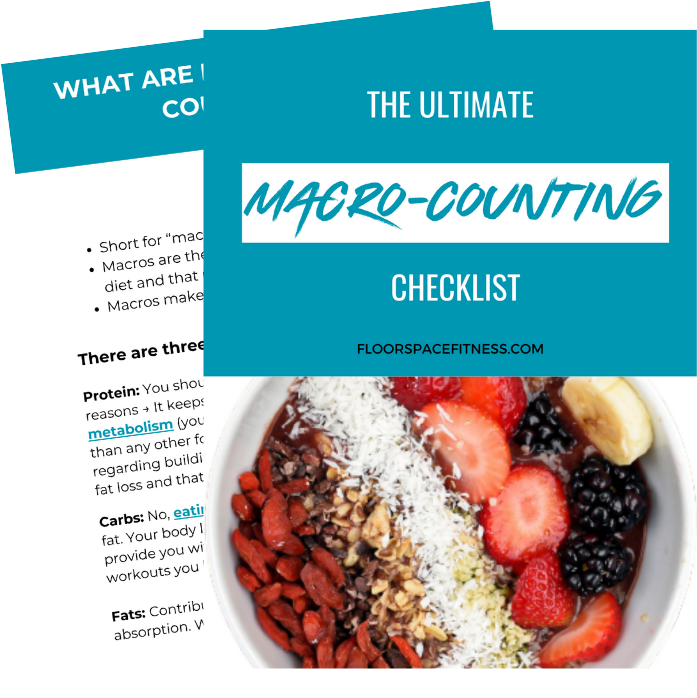
What is the weight loss golden rule?
Simply put, to lose weight you have to be in what’s called a “calorie deficit.”
Being in a calorie deficit means you’re consuming fewer calories than you burn.
In other words, calories in < calories out.
You can’t sneeze with your eyes open (go ahead and try it) and you won’t lose weight without a calorie deficit.
There’s just no way around this, it’s a scientific fact.
It does and always will come down to total calories.
This post is for you.
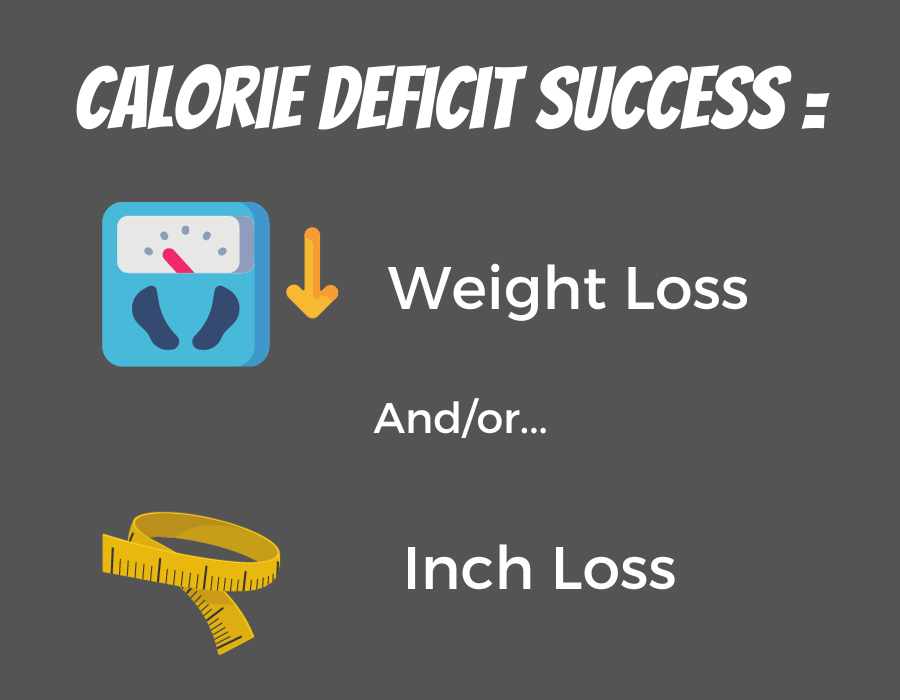
Meaning your diet drives weight loss more than anything else.
(The phrase “you can’t out-run your fork” couldn’t be more true).
So what gives?
You’ve been eating healthy and STILL the weight just hasn’t come off.
I hate to be the bearer of bad news but that just means you’re not actually in a calorie deficit.
And despite eating “healthy” you’re consuming more calories than you need to.
And as long as you’re consuming the number of calories you should be for weight loss (I.e. you’re in a calorie deficit), that’s exactly what’ll happen.
The scale will trend downward and you’ll lose weight.
While losing weight comes down to total calories, that doesn’t mean you just throw food quality out the window.
As a little precursor to what we’ll get to here in a second, that’s what counting macros helps with.
Counting macros empowers you to have a more filling, balanced diet across the board.
Notice how I said “balanced,” which means you won’t have to deprive yourself and give up your favorite sweets, treats, and snacks just to see progress.
I should also point out that counting macros 101 doesn’t just have to do with weight loss.
The reverse is also true.
If your goal is to build muscle–I.e. get that booty poppin’ like a firecracker or build a bigger chest and bigger arms–you need to be in a calorie surplus (taking in more calories than you burn).
Then, there’s maintaining your weight.
If you want your weight to stay relatively the same, you eat just as many calories as you burn.
This is known as your TDEE (or maintenance calories).
Counting macros 101: What are macros and why count them?
Macro is short for “macronutrient.”
These are the nutrients we eat the most of in our diet and there are three main ones:
- Protein: Eating more protein has a ton of benefits outside of the ones I’m about to list but here are three I think you’ll really like → It’s insanely filling, you speed up your metabolism by eating it (Your body burns more calories digesting protein than any other food), and it’s the most important food type regarding building/preserving muscle mass. Muscle = greater fat loss and that toned, more defined physique you’re after.
- Carbs: There’s this misconception that carbs are bad for you. Some people say they make you fat and that you should avoid carbs like the plague. Want to know something? If carbs automatically just make you fat then the Tooth Fairy actually exists. Your body doesn’t hate carbs. It loves them. They’re your main fuel source and what gives you energy to have productive workouts in the gym. Better workouts = greater progress. Unless you have prediabetes, diabetes or some type of medical condition where you’re monitoring your carb intake, don’t live in fear of carbs.
- Fats: Similar to carbs, fats don’t make you fat. They’re an essential part of any diet. One of fats’ main contributions is helping with nutrient absorption.
Here’s an easy way to think about counting macros:
The calories in a given food are a giant pie and macros are the slices that make up that pie.

The protein slice of calories will be a lot larger than the carb or fat slices.
Whereas a food like bread will have a much higher carb slice than protein and fats.
Or think about a food like a cheeseburger.
You get a mix of protein, carbs, and fats.
The meat is primarily protein and fats while the bun is mainly carbs.
The cheese, butter, and any cooking oil used also come from fat.
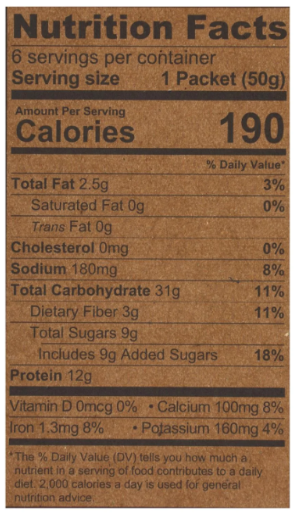
It comes from my favorite type of oatmeal – Kodiak Cakes – Oatmeal Cinnamon.
- Throw a little brown sugar in there
- Add about a half serving of peanut butter
- Slice up an apple and toss that in too
You’ll thank me later, trust me.
We’ll go over this in more detail later on when we talk about the 4-4-9 rule but for now know this about the numbers: All the grams added together of protein, carbs, and fats equals the 190 calories in a serving size for the oatmeal (FYI, some foods may be a few grams off because of rounding).
It’s not going to make sense right now but I promise it will.
So just file this away and we’ll come back to it.
Counting macros 101: The BEST thing about tracking your macros

Which is a good thing because when you have balance you’ll actually be able to sustain your diet.
You make weight loss more fun when you don’t feel all miserable and deprived.
That means no more suffering through any more 1,200-calorie crash diet foolishness.
You need to eat more calories if your goal is weight loss.
No, it’s not because eating “too few calories” puts your body in “starvation mode.”
It’s because when you don’t eat enough calories, you end up binging (especially on weekends) on all the foods you gave up just to hit a 1,200 calorie number that would even have most toddlers looking at you crazy.
As long as you hit your macro targets, you can “fit” or “work” any food you want into your diet and still see the progress you’ve always wanted.
I know you’ve probably started thinking of all the foods you can’t wait to include in your diet.
The pizza, wings, burgers, fries, cookies–it’s all calling your name right about now and your mouth is watering.
Believe it or not, that’s all surface-level stuff.
I mean, OBVIOUSLY, it’ll feel great making healthier food choices while still getting to enjoy your favorite sweets, treats, and snacks.
But if you dig a little deeper into what counting macros can help you accomplish, you’ll see this can be a great tool to help you finally break free of your all-or-nothing mindset when it comes to nutrition and form a more positive relationship with food.
Related: The ideal mindset for weight loss.
That’s not how things have to be.
Counting macros will help you realize the facts–there is no such thing as “good” or “bad” foods.
ANY food can be had within your diet, at ANY time.
The key is just to do it in moderation.
In the mood for some ice cream?
Rather than getting the whole pint, grabbing a spoon, and sitting on the couch mindlessly eating as you watch TV, scoop out a serving size and grab some fruit to add more food volume.
That’s just one example to give you some ideas but I think you get what I’m trying to say.
What’s the difference between counting macros and calorie counting?

“If I’m keeping track of how much I’m eating, am I not counting calories?”
It’s a good question and it’s one I’ll answer right now.
You’re counting calories when you count macros.
But tracking macros takes things one step further.
When you count calories, you’re only concerned about your total caloric intake.
Whereas when you count macros, you’re tracking not only overall calories but also how those calories are broken up among protein, carbs, and fats.
For example, look at this nutrition label:
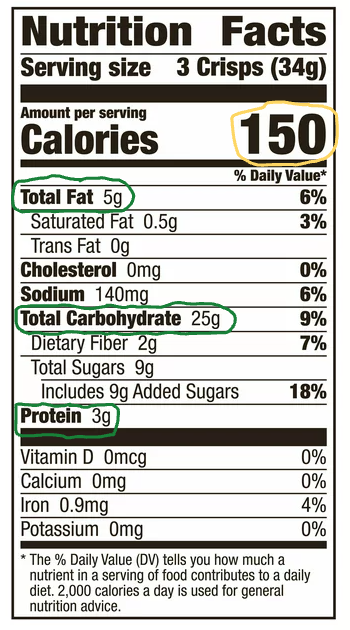
Counting macros means you keep track of all of the numbers circled in green (protein, carbs, and fats), which add up to the calorie total in yellow, as I mentioned earlier.
Let’s say you were to just focus on counting calories.
That might not exactly lead to the most balanced diet because your sole focus will be on staying within your calories.
There’s one macro in particular that is super costly not to keep track of and that’s protein.
As you know, protein is PIVOTAL to building/preserving muscle mass.
You won’t be toned, defined, or whatever word you want to use without adequate protein intake.
Know what else is super important for achieving your ideal physique?
This doesn’t mean lifting “lighter weight for reps,” Orange Theory, or HIIT.
It also doesn’t mean going to the gym, walking around, trying out a few machines, and then saying peace out, mission accomplished. ✌🏾
Lifting weights means being on an actual program where you’re applying progressive overload.
That’s how you achieve the most gains and get the best results possible.
Download my free 12-week dumbbell workout plan if you want everything all laid out for you in terms of your strength training.
This entire workout plan can be completed right in the comfort of your own home or you can take it with you to the gym.
All you need are dumbbells and some floorspace.
That’s literally it.
Counting macros 101: How do you calculate macros for beginners?
We’ve covered a lot so far but I think this is the part you’ve really been looking forward to.
You know what macros are and the benefits of counting them, so how do you calculate your own?
I’ll show you how in just two easy steps below.
Step 1: Find your weight loss calories
First, you need your TDEE (or maintenance calories).
TDEE stands for total daily energy expenditure and it is the number of calories you’d need to eat to maintain your current weight.
Use this calculator to find your TDEE.
Put in all your info and it’ll spit out your TDEE number.
Take 80% of that and those are your weight loss calories.
For example, let’s say your TDEE is 2,500 calories. That would make your weight loss calories 2,000 (0.8 x 2,500 = 2,000 calories).
Step 2: Divide your calories up into protein, carbs, and fats
- Protein: This is the one macronutrient you want to keep constant. Again, protein keeps you full and satisfied, it helps you burn more calories and it allows you to build and maintain muscle (muscle = more fat loss and a leaner, fitter, and more aesthetically pleasing physique). Set your daily protein target anywhere from 0.7g-1g per pound of your current body weight. If you have a significant amount of weight you want to lose, go ahead and shoot for that same target but of your goal body weight.
- Fats: Your ratio of fats will fall somewhere between 20-35% of your total daily calories.
- Carbs: These come last but you can always tinker with the numbers if, in the end, you don’t like the way they come out.
Counting macros 101 example
To show you what calculating your macros would look like, let’s run through a quick example. Let’s say our example person weighs 200 lbs and their weight loss calories are 2,500.
Protein macros
Protein wise, that’s easy (Somewhere between 0.7g-1g per pound of body weight).
Let’s go with 1g per pound.
That would give us 200g of protein per day (1g per lb x 200 lbs = 200g).
How many calories is that though?
I told you to file this away for later and later is here.
You can figure out how many calories 200g of protein is by using the 4-4-9 rule.
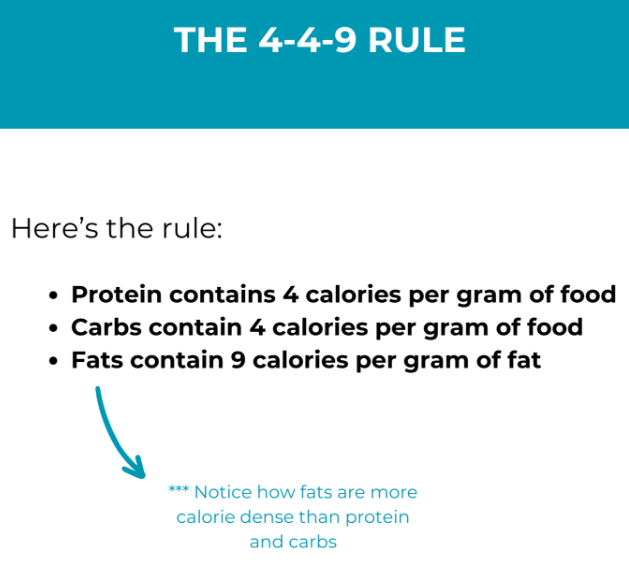
200 grams x 4 calories per gram of food = 800 calories.
So 800 calories are coming from protein.
Write that down.
Fat macros
Roughly 20-35% of your calories should come from fat.
For our example person, let’s go with 30%.
Here’s the math for that:
0.3 x 2,500 = 750 calories.
Next we apply the 4-4-9 rule to get your fats into grams.
Fat contains 9 calories per gram so…
750 calories / 9 calories per gram = 83 grams of fat.
Carb macros
You know total calories are 2,500. After subtracting calories from protein and fats you’re left with 950 calories (2,500 – 800 – 750 = 950).
Use the 4-4-9 rule to get your carbs into grams: 950 / 4 = 237 grams of carbs.
Final macro stats
- Protein: 200 grams totaling 800 calories
- Fats: 83 grams totaling 750 calories
- Carbs: 950 calories totaling 237 grams
Something to make note of.
I mentioned this earlier but your numbers won’t always add up EXACTLY to your total calories.
In our example, you’d be about 5 calories off.
That’s just due to rounding.
As long as you’re in that 5, 10, 15 calorie range or right around it, don’t sweat it.

Counting macros 101: How to log your food
Knowing what your macros are and how to calculate them are all well and good.
But how can you ensure you’re actually hitting your targets on a daily basis?
To be as accurate as possible keeping track, here are the steps you can take:
1. Download a macro/calorie counting app
You could go old school–grab a pen and piece of paper and manually track all your macros.
But that doesn’t exactly sound like the most fun thing in the world.
Talk about hand cramps.
I’ve been using MyFitnessPal for the last 7-ish years and have no complaints at all.
It’s free but there is a premium version you can pay for (which I personally don’t think is necessary).
MyFitnessPal isn’t the only app out there so you may want to do some of your own research to find the one you think would be best for you.
2. Buy a food scale
Part of counting macros means actually weighing out your food.
And to be as accurate as possible, you do that in GRAMS.
Not measuring cups, spoons, or dare I say, try to eyeball your portion sizes.
Grams, grams, grams.
Invest in a food scale, you can get one off of Amazon for about $20-$30.
3. Read through the resources below
These resources will show you how to count macros and log your food no matter the situation:
- Read this article on how to log individual foods like turkey breast, sweet potatoes, and peanut butter.
- This article will help you with calculating macros in a recipe or homemade food.
- Read this article on how to track macros while eating out.
FYI, the three articles above were written from a calorie counting perspective but the same principles apply.
On top of tracking total calories, you’ll just have the added focus of logging where those calories come from (I.e. protein, carbs and fats–your macros).
You can swap out counting “calories” for counting “macros” in those articles. 🙂

Counting macros 101: When should you recalculate your macros?
Or maybe you think you might be in one already but don’t know whether or not to adjust your macros.
Here is the main question I would ask myself: How consistent have I truly been?
Being consistent means:
- Counting your macros correctly: You’re weighing out your food in grams, you track ALL meals (even on the weekends), you account for all the little bites, nibbles, and snacks you have throughout the day, etc.
- Lifting heavy weights 3-4 times per week on an actual strength training program. Random workouts do not equal strength training. HIIT and Orange Theory also do not count as true strength training. Unsure if something counts as strength training? You having to ask the question probably means it doesn’t.
- You hit your daily step goal: Somewhere between 7,500–10,000 steps a day is ideal.
You should only recalculate your macros if you’ve been at least 90% consistent over the past month in the three areas I’ve described above.
If you’re falling short in one or more areas, just hone in and focus on being more consistent.
If you’ve gone through the checklist and can say definitively, “I’m still not losing weight,” you have two options.
A.) You can reduce your calories by about 100-200. Don’t mess with protein! Take the calories out from either carbs or fats.
B.) Add 1-2 LISS cardio sessions (I.e. walking on the treadmill or StairMaster, using the elliptical, etc) for 20-30 minutes each.
Don’t do more work than you have to.
Pick one to start with, try it out for 2-3 weeks and if that doesn’t work, add in the other one.
Best tips for counting macros
If you haven’t been losing weight counting macros or just want to get a leg up and avoid some of the most common mistakes, this article has all the tips you need to be a successful macro counter.
Best foods for counting macros
Remember, you don’t want to look at things like these foods are “good” and these foods are “bad.”
You can have any food you want, as long as you do so in moderation.
When it comes to balance, here’s how I’d look at things:
The majority of your diet (around 80%) should be made up primarily of “more nutritious” foods like chicken breast, potatoes, eggs/egg whites, fruits, and veggies.
Then, you can fill the other 20% of your diet with your favorite “less nutritious” fun foods like pizza, wings, burgers, and fries.
With that said, start prioritizing this type of food in your diet if you haven’t already…
Fiber.
What’s so special about it?
A lot of things.
For one, it’s similar to protein in the sense that you’ll stay fuller for longer by eating it.
Two, there are so many health benefits to gain by including more fiber in your diet.
Here are just a few of them:
- You lower your risk of heart disease by 9% for every 7 grams of fiber you eat.
- You lower your risk of breast cancer by 5% for every 10 grams of fiber you eat.
- Regularly eating enough fiber reduces your all-cause mortality risk (chances of dying from virtually anything) by 19%.
25g for women and 35g for men per day are good targets to shoot for in terms of fiber consumption.
Counting macros 101: Something important to be aware
I saved this for last because I think it benefits you to know about the three primary macros and the role they play in making up the calories of the foods you eat.
Understanding the breakdown of what’s in foods (I.e. their protein, carb, and fat content) helps you make more informed nutrition decisions and have a more well-rounded diet.
The info we’ve gone over in this article is especially important for beginners.
I started with counting macros 101 just like you’re doing now.
But once I got that basics down I made a transition.
And that was to just keep track of total calories and protein intake.
Why did I stop tracking carbs and fats?
As I said, it’s good to have a basic understanding of all three macros.
But in the grand scheme of things, your overall calories and protein intake are most important when it comes to fat loss.
This is me saying that “technicaaaaally” you don’t have to keep meticulous track of all three macronutrients.
If you want, you could really just let carbs and fats fall where they may.
Or if you do decide you want to keep track of all three to ensure your diet is as balanced as it could be, just experiment a little and see what ratios of carbs and fats work best for you.
To this day, I truly believe the foundation I built by starting off tracking all three macros has helped me exponentially in terms of my nutrition.
And it can do the same for you. 💪🏾

Macro counting 101: Frequently asked questions
How fast can you lose weight by counting macros?
This is just a general guideline (key word: GENERAL) but if you remain consistent with counting macros, you can expect to lose about 0.5 lbs–2 lbs per week.
There are two things I want to point out here:
1.) Weight loss takes time so patience and consistency are key. You won’t see progress EVERY SINGLE DAY.
Weight loss isn’t linear, so it won’t happen in a straight line down like this:


You have to stay the course and remain consistent even when you feel like what you’re doing isn’t working just because the number on the scale isn’t going down.
That brings me to the next point…
2.) Speaking of the scale, there are many more ways to measure progress than just the one number it spits out.
Are your measurements going down? → Inch loss = fat loss, and fat loss is what you really should be after.
Are your clothes fitting better?
How are you looking through your progress pictures?
Are you getting stronger?
Do you have more energy and confidence?
What is the best macro ratio for fat loss?
As is the case with a lot of things in the fitness world, there isn’t one universal best answer that just applies to everyone.
Keep protein constant ( 0.7g-1g per pound of body weight every single day).
If you have a decent amount of weight you want to lose, aim for that same amount but of your goal body weight.
When it comes to carbs and fats, experiment with the numbers and find what works best for you.
Some people like a diet higher in carbs, others higher in fats.
What is the 30-30-40 rule?
It’s just a way that you can split out your macros.
According to the “rule” your macro ratios would be: 30% protein, 30% fats, 40% carbs.
The reason I have the word “rule” in quotes is because this isn’t something you have to follow.
Again, keep protein intake constant at 0.7g-1g per pound of body weight (or goal body weight if you have a significant amount to lose).
Then you can distribute the rest of your calories between carbs and fats.

What's up?
I’m Chad, I’m happy you’re here! I’m a certified personal trainer and my goal is to help you form practical, sustainable habits that lead to permanent fitness results. If you want to lose fat, build muscle, and live a healthier, happier life then you’re right where you need to be. 💪🏾
Free resources
⬇⬇⬇






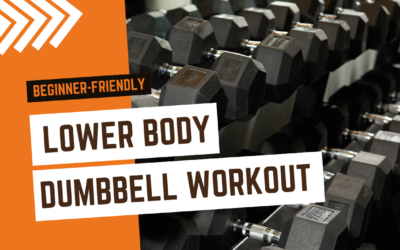
0 Comments